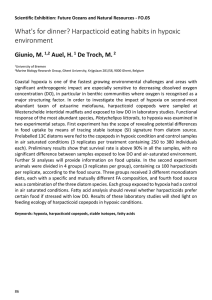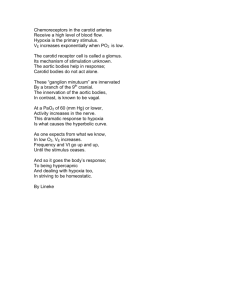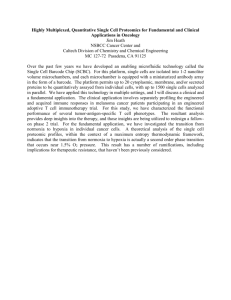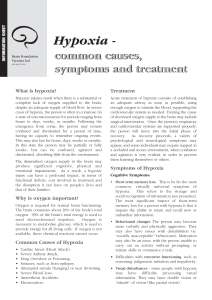PET Imaging of Hypoxia John Humm, PhD Dept. of Medical Physics MSKCC
advertisement
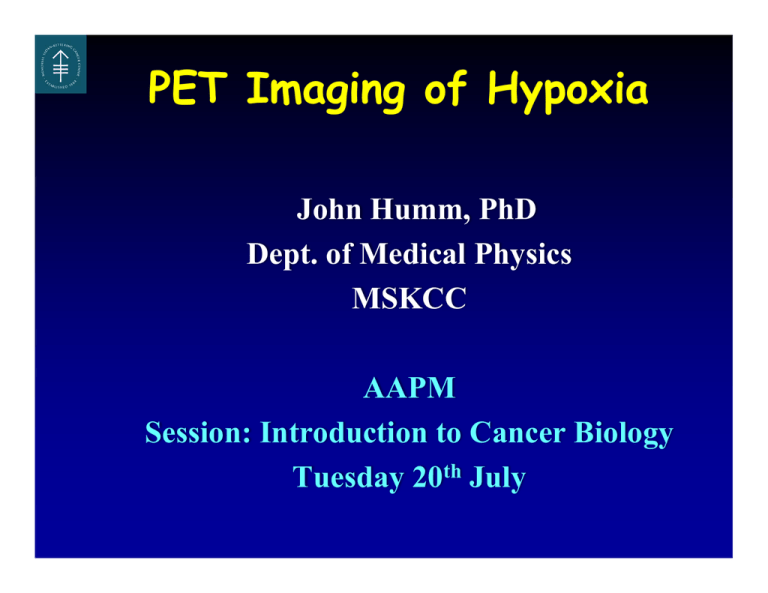
PET Imaging of Hypoxia John Humm, PhD Dept. of Medical Physics MSKCC AAPM Session: Introduction to Cancer Biology Tuesday 20th July Many strong hypoxia radiotracer imaging programs University of Washington Seattle have been studying 18F-FMISO since 1996. Washington University in St. Louis developed Cu-ATSM. The group at Edmonton developed a family of hypoxia compounds including IAZA, FAZA and IAZGP UPENN developed 18F-EF5 What do PET images of hypoxia look like? 60Cu-ATSM Chao et al., IJROBP 49;1171, 2001 18F-FMISO Lee et al., IJROBP 40;2, 2008 What can be gained from hypoxia imaging? (i) Is this tumor hypoxic? Identification of tumor hypoxia as a prognostic indicator of treatment outcome (Höckel et al. Can Res 56: 4509, 1996) (ii) Where is it hypoxic? Determination of the spatial distribution of hypoxia for the purpose of radiobiologically driven dose painting (Ling et al Int.J.Radiat.Oncol.Biol.Phys.47: 551, 2000) Methods to measure hypoxia I pO2 probes Eppendorf & OxyLite Frequency % 50 8-10 mm FSa-II Tumors Total 175 Readings in 5 Tumors 40 30 20 pO2 probe - MicroPET images of hypoxia tracers 0 2.5 7.5 12.5 17.5 22.5 27.5 32.5 37.5 42.5 47.5 52.5 57.5 62.5 67.5 72.5 77.5 10 pO2 in mmHg 2 Methods to measure hypoxia II Resect Tumor, Freeze & Section MicroPET images of hypoxia tracers Immunohistochemistry & Autoradiography 2 Methods to measure hypoxia III MRI Gd-DTPA blood flow Compare to other Imaging Modalities c MicroPET images of hypoxia tracers Electron Spin Parametric Resonance Courtesy Howard Halpern University of Chicago 2 Figure 8 : 131 I- Methods to measure hypoxia IV Hypoxia Responsive Element (HRE) RX/HIF1α TG Transfect tumor cell lines with a plasmid containing a reporter gene under the regulation of HIF – in this case with a TkGFP reporter construct EcoRI Autoradiograph of the Hypoxia Tracer Autoradiograph of the reporter construct 18F-FMISO 124I-FIAU 18F-FMISO Scans of H&N Patients The concept of a GTVh CT FDG FMISO Lee et al, Fluorine-18-Labeled Fluoro-Misonidazole Positron Emission and Computed Tomography Guided Intensity-Modulated Radiation Therapy in the Treatment of Head and Neck Cancer. IJROBP 2008;70(1):2-13. How do we define the hypoxic volume on an 18F-FMISO PET image? • What criterion do we use to segment the hypoxic tumor sub-volume? • How reproducible is an 18F-FMISO scan? Effect of segmentation threshold FDG-FMISO T/B > 1.0 FDG-FMISO T/B > 1.2 FDG-FMISO T/B > 1.4 PET VOXELS Hoechst 33342 - BLUE Pimonidazole - GREEN Why are the 18F-FMISO uptake ratios so low Comparison of 2 pre-treatment 18F-FMISO scans FMISO1 vs. FMISO2 Day0 FMISO image Day3 FMISO image Plot registered voxel intensities from 1st FMISO image with the 2nd 18F-FMISO Dynamic PET A(t) [Bq/cc] Analysis of Hypoxia criterion TumorBlood Ratio(T:B) ≥1.3 not reliable t [min] Kinetic analysis of Time-Activity Curves (TAC) is necessary Thorwarth et al, BMC Cancer. 2005 Dec 1;5:152. A compartmental model to mimic FMISO metabolism. Plasma k1 Cp k2 Free/NS Bound Bound k3 C1 C2 [O2] H&N Patient Dynamic PET Images Carotid artery 1 min 2 min 3 min 4 min 10 min 15 min 20 min 25 min 5 min 30 min tumor 90 min 95 min 180 min 185 min CT 17 Parametric Images of Cp(t) k1 C1(t) k3 18F-FMISO C2(t) k2 46 voxels Concordance CT 3hr FMISO k3 map k1 map Parametric Images of 18F-FMISO Discordance CT 3hr FMISO k3 map k1 map 51 voxels Validation of Parametric Images Image Guided pO2 Measurements pO2 tracks overlaid on the late and parametric image maps Track 1 Track 2 Track 3 Track 2 Track 3 T:B Late Image Track 1 k3 Hypoxia Image Correlation of parametric rate constants to pO2 track values k3 [min-1] k3 k1 k1 0.14 0.12 k3 0.030 0.745 0.025 [ml/min/g] K1 [ml/min/g] -1 k3 [min ] 0.10 0.08 0.06 0.04 0.015 0.010 0.005 0.02 0.00 0.1 0.020 1 10 pO2 [mmHg] 100 0.000 0.1 1 10 pO2 [mmHg] 100 Conclusions • Radiobiological dose painting may be a possibility but there are many obstacles. • Validation steps is still ongoing, but appear promising in spite of the difficulties. • Ideally we would like to be able to image the patient at one single time point and obtain a map of the hypoxia distribution, but kinetic analysis may be a necessary. • At a minimum. hopefully we will be able to strategy patients by hypoxic volume. Acknowledgements Dept of Medical Physics C. Clifton Ling Ph.D. Pat Zanzonico, Ph.D. Joseph O'Donoghue, Ph.D. Sean Carlin, Ph.D. James Russell, Ph.D. Sadek Nehmeh, Ph.D. Andrei Pugachev Ph.D. Wenli Wang, Ph.D. Rachel Bartlett, Ph.D. Nuclear Medicine Service Steven M Larson, MD Heiko Schöder, MD Cyclotron / Radiochemistry Jason Lewis, Ph.D. Shangde Cai, Ph.D. Howard Sheh, M.S. Peter Smith-Jones Ph.D. Radiation Oncology Nancy Lee, MD Gloria Li, Ph.D.


